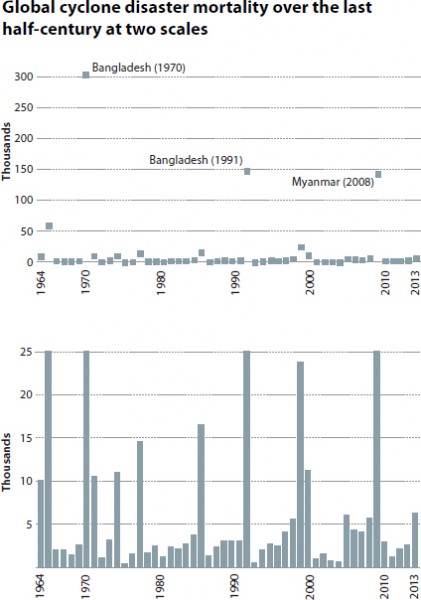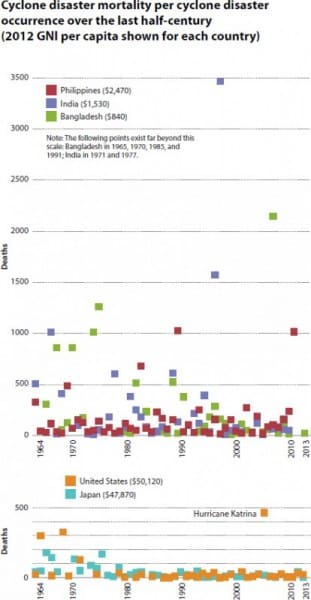Poverty and Vulnerability to Storms
Typhoon Haiyan, which hit the Philippines on November 2, 2013, left behind more than 6,000 dead and displaced a population the size of Los Angeles. The scale of the damage is a result not only of the severity of the storm but also of the vulnerability of the millions of impoverished people living in the Philippines. Fragile food security leads to acute malnutrition with long-term effects, limited health and sanitation infrastructure results in the spread of disease to more victims, and the poorest surviving households are pushed further into debt. This vulnerability has been compounded throughout a decade that has included a succession of major typhoon disasters.
Typhoon is a regional name for a tropical cyclone, and it’s a familiar word in the Philippines, which has been the country most often struck by these disasters during the past decade and the past half-century. Other countries that have suffered catastrophic storm damage—Bangladesh, China, Myanmar, and India—are also examples of how poverty increases vulnerability.
Philippine vulnerability
In the Philippines exposure to typhoons is inescapably high. The geography makes coordinated efforts to reduce disaster vulnerability critical. But over the past half-century mortality per million people shows no appreciable decline. Vulnerability resulting from growing coastal populations living in unsafe housing combined with environmental degradation can outpace even the largest evacuation and response plans.
Source: EM-DAT and The World Bank
Recent cyclone disasters in India and Bangladesh reveal major improvements in disaster preparedness. In India, Cyclone Phailin in 2013 caused 38 deaths, a vast improvement from the 10,000 deaths resulting from a similar storm in 1999. In 2007 Cyclone Sidr in Bangladesh caused the enormous loss of 4,400 lives, but this is far fewer than the almost 140,000 lives lost in a comparable storm in 1991. But similar improvements in community resilience are yet to be made in many other regions, as was tragically apparent in Myanmar in 2008 when a storm claimed more than 138,000 lives. Disaster preparedness programs that can evacuate and shelter millions of people take years to implement.
An illustration of the socio-economic capacity needed to protect against disasters can be seen in the mortality data for the affluent storm-prone countries Japan and the United States. The only outlier is the high mortality caused by Hurricane Katrina, which affected one of the poorest regions in the United States. Storms are inevitable, but the resulting death and destruction can be limited with adequate preparation. Poor people, especially in developing countries, are particularly vulnerable to storms. They deserve better protection.
Data for the figures are from the Emergency Events Database (EMDAT), maintained by the World Health Organization Collaborating Centre for Research on the Epidemiology of Disasters (CRED). Population and gross national income (GNI) per capita data are from the World Bank world development indicators.
Deadly storms
Globally, cyclone disaster mortality has exceeded 10,000 deaths in 11 of the past 50 years. Four years in the past decade have exceeded 5,000 deaths. These figures show that cyclones are an enormous and relentless threat to human life.
Source: EM-DAT
Poverty matters
The occurrence of a cyclone remains a deadly hazard for people living in countries with low gross national income per capita such as the Philippines ($2,470), India ($1,530), and Bangladesh ($840). These storm events are not included because they far exceed the scale shown here: Bangladesh in 1965, 1970, 1985, and 1991; India in 1971 and 1977. By contrast, wealthy countries such as Japan and the United States suffer relatively low mortality rates when they are hit by powerful storms because they can afford to invest in the infrastructure and other measures needed to reduce their vulnerability.
Source: EM-DAT and The World Bank



